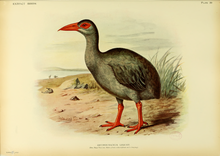- Rodrigues Rail
-
Rodrigues Rail 
Conservation status Scientific classification Kingdom: Animalia Phylum: Chordata Class: Aves Order: Gruiformes Family: Rallidae Genus: Aphanapteryx Species: A. leguati Binomial name Aphanapteryx leguati
(Milne-Edwards, 1873)Synonyms Erythromachus leguati Milne-Edwards, 1873
Miserythrus leguati Newton, 1893The Rodrigues Rail or Leguat's Gelinote (Aphanapteryx leguati) is an extinct bird named after the learned traveller François Leguat, who came with a band of Huguenot religious refugees to Rodrigues in 1691 and stayed there for two years. It was also mentioned by Julien Tafforet in 1726. The Rodrigues Rail was a plump, flightless rail with bright gray plumage - probably an effect caused by fine grey and white mottling or vermiculations like on a mallard drake's flanks - and conspicuous red bill, feet and eye wattles. It was somewhat smaller than its relative, the Red Rail of Mauritius. The strong bill varied much in size and shape, some specimens having shorter and almost straight bills, others being much longer and prominently curved. It is unknown whether this related to sexual dimorphism or to individual variation or even to a genetic plasticity in bill shape and size that responds to differential food availability, as had been shown in some Darwin's finches. Leguat's account does suggest that he could not discern marked differences between the sexes.
It seems to have occurred mainly in the coastal forests of the island, as the larger and more conspicuous Rodrigues Solitaire, which preferred the deep inland forests, was still seen after the rail's extinction. Had these birds shared the same habitat, the solitaire would certainly have become extinct before the rail. The birds fed on invertebrates, possibly small vertebrates, and in the turtle's nesting season they dug up and fattened themselves on their eggs; it seems thus likely that like the Solitaire, they had an annual cycle of becoming fat and slim, corresponding with varying availability of food in the wet and dry seasons. Its vocalizations were a continuous whistling, but the alarm call was a hiccup-like staccato. The eggs and nests of the birds were not located by Leguat and his companions.
Extinction
The rail was extensively hunted for food by the early settlers. The fat of birds that had been feeding on turtle eggs was bright orange and considered very good to assist recovering from illness (it was probably rich in carotenes derived from the eggs' yolks). Leguat mentions that the birds were taken in a way similar to the method used on Mauritus to catch Red Rails: a piece of red cloth was shown to them, to which they responded by aggressive behavior; having no fear of humans as they evolved in the absence of predators, they jumped at the cloth and tried to tear it apart, enabling the hunters to catch them in numbers. Although the Rodrigues Rail managed to hold its own against the rats that had been accidentally introduced in the late 17th century and multiplied by the time of Leguat's visit, it was unable to withstand the persecution by humans. Pingré mentions in his 1763 report that the bird was extinct by 1761. No skins of the bird have survived; today, it is known only from the two descriptions and a large number of subfossil bones.
References
- BirdLife International (2004). Aphanapteryx leguati. 2006. IUCN Red List of Threatened Species. IUCN 2006. www.iucnredlist.org. Retrieved on 22 Jun 2006. Database entry includes justification for why this species is extinct.
- Milne-Edwards, Alphonse (1873): Recherches sur la faune ancienne des Îles Mascareignes. Ann. Sci. Nat. Zool. (Paris) 5(19), Article 3, plates 11-12. [Article in French] Note: Usually, the year of publication is given as 1874. However, although the volume was nominally of that year, it was already released in 1873.
Categories:- IUCN Red List extinct species
- Aphanapteryx
- Extinct flightless birds
- Bird extinctions since 1500
- Animals described in 1873
Wikimedia Foundation. 2010.

